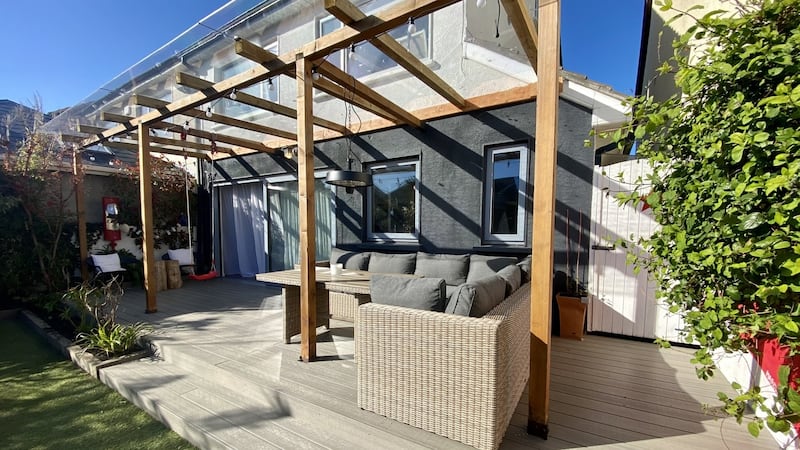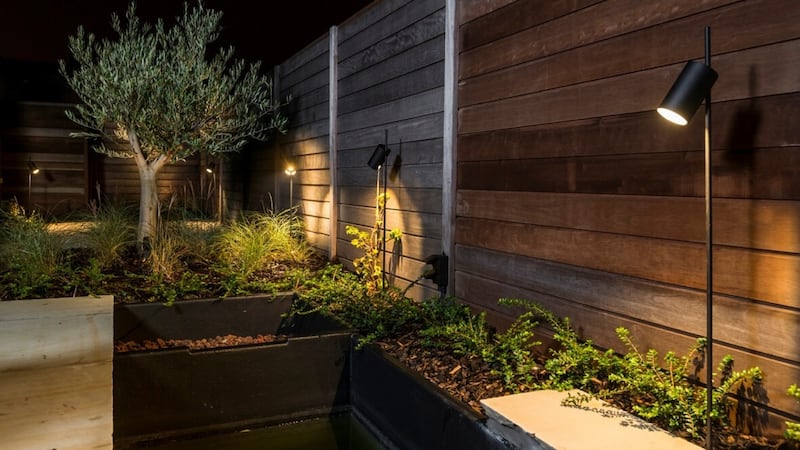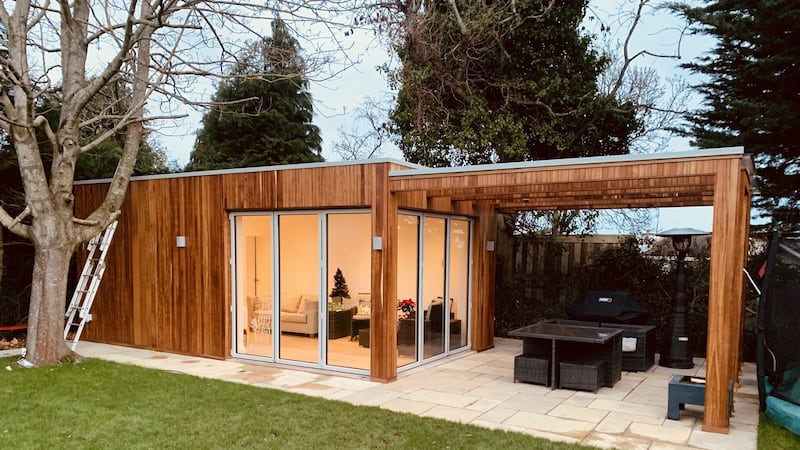It’s that time of year when thoughts turn to building projects in the garden. But with suppliers so busy post-lockdown that many are not even quoting for work, you may need to take matters into your own hands. So, what’s involved and will the job add value to your home? Here are five projects to consider.
Patios
“The patio has become the number one DIY job to do to ready the garden for summer,” says John Maypother of Cabinteely-based The Patio Centre. “Laying it is all in the prep work.” He says most of his clients follow YouTube tutorials.
Getting the area level is the first consideration, allowing for some run-off for water, especially if you want the patio to sit flush with interior flooring – in this instance using a stone/tile that is similar in colour to the flooring to better tie the two spaces together. For this you will need damp-proof coursing and then a hardcore base to a 50mm depth. A sand and cement mix is laid onto this.
Materials to cover an area of about 20sq m of patio will cost from about €1,200, he says. Rolls of polyurethane to cover flooring and a narrow wheelbarrow to transport materials are additional costs for those in terraced properties.
If you don’t want to DIY, The Patio Centre can recommend tradespeople. The same-sized patio would start from about €3,500, which will make even a small terrace – such as the one pictured above featuring new garden furniture from Very Good and Proper – look chichi smart.
What about moss or mould? A patio needs to be maintained, swept regularly to remove summer grass cuttings and dead leaves in winter, and washed with either Jeyes Fluid, bleach or washing-up liquid to keep mould at bay. Being less porous, porcelain tiles are easier to maintain than stone, and less likely to be susceptible to damp, moss or mould. Don’t use acids such as sulphuric acid or citric acid – although the latter is great at removing oil stains from paving or cobblelock. Avoid using a pressure washer, he says. “It loosens grout and pointing.” Will it add value? Yes, says Ronan Crinion of Move Home Estate Agents.
"Buyers never really focus on its condition, even if it's made from concrete or has a drainage cap in its middle. It's a recreational area. It's always a plus."
thepatiocentre.com
Decks

When done well, decking can transform the most modest of spaces. For the Irish climate Pat Moore, a director at Chadwicks, recommends the composite kind, a material made from a mix of recycled wood particles and polyethylene. DIYer Dave Moore of Today FM’s Dermot and Dave Show started out hanging pictures and developed his skills working on his own home, graduating to timber decking a decade ago. He recently built a pergola with polycarbonate roof atop it and realised he needed to upgrade it. The musician – who currently has a working relationship with the builders’ providers, posting social media stories for the firm on his efforts – built the sub-frame by laying plastic pedestals, 240 in total, that can be leveraged up like a car jack to raise it off the ground to mark out the base. Aluminium joists are then used along the pedestals and the composite beams slot into these.
“Building the sub-frame takes time and knowledge, but there are how-to video instructions on some of the composite board suppliers’ websites that help you figure it out,” he says. These include Co Louth-based the White River Group.
Further reading: Chadwicks’ decking and paving brochure has step-by-step instructions, available in stores.
Take note: Mistakes cost money. Replacing softwood timber costs €20 per sq m versus from €52 per sq m for composite.
Will it add value? “People want low-maintenance gardens, so go for composite,” says Andrew Foran, head of valuations at estate agents Quillsen.
"While any garden enhancement will add outdoor living value, consider planting that will mature to help soften the effect."
chadwicks.ie; wrg.ie; @davetodayfm
Outdoor lighting

Because we spend most of our time looking out into the garden, we need to consider how it looks from the inside out, says Rocky Wall of Wink Lighting.
“Exterior lighting can be ferociously expensive and many overdo it. What you want is a visual connection to the outdoors, so pick out three things you’d like to highlight – it could be a tree, a statue or even a shed. By suspending a pendant from a tree, for example, you will get movement and shadow play when the wind blows and this will connect you to the elements.”
He suggests different illumination treatments for different specimen trees and the use of warm rather than cold whites.
“A narrow-beam light will pick out the trunk and beautiful bark of a silver birch, for example, while it’s the canopy of a magnolia that is interesting. You can play with depths of field too, using plexi mirror – acrylic sheeting that you can set behind a wall of bamboo, for example, to make it appear as if forest thick. Affix in a slightly concave or convex fashion and the reflection will become even more intriguing.”
If you don’t want to do-it-yourself, a Wink site visit costs €450, ex-travel, and includes advice and quotes for fixtures. Wall says prices for fixtures will range from €20 for a plastic one to €200/€300 for a longer-lasting design.
Other practicalities? Marine-grade lighting is more expensive but, with 40 per cent of the population living within 5km of the coast, it should be a consideration; otherwise screws will rust or you won’t be able to open the light fixture to change a bulb.
When not to do it: If you’re only at the planting stage of your garden then just lay cabling for now and let it mature a bit first.
Will it add value? Yes, if its done well, says Dan Steen, senior negotiator at DNG. "But rusted fittings or exposed cables will scare buyers. It will make them think there's a problem with the electrics. Any works should be done by a registered electrician."
wink.ie
Pergolas

“Traditionally, a pergola was a timber structure designed as something to grow plants on,” says Ross Farrell of Greenstone Landscapes. “A lot of contemporary designs feature just one beam, while the more classic approach is as a shaded walkway. In Ireland we use it to get out of the rain.”
It can orient an area within a garden to face south, when the garden itself doesn’t, or can shield an unsightly aspect.
Pressure-treated timber posts treated with UV oil are used. The post ends should be put into waterproof bags before being set into the ground, often in concrete. Prices to design and install cost from about €5,000, Farrell says.
What to plant? Farrell suggests clematis varieties, hydrangea, wisteria, climbing or rambling roses or trachelospermum jasmine, star jasmine, which is evergreen and has a woody smell.
Any advice? It should not exceed 2.5 metres high. Show the neighbours any designs or mock up a couple of posts as well as a horizontal top post so they can actually see the proposed structure in situ if its going to be positioned near their adjoining wall.
Will it add value? "It might make it more appealing and be part of the reason a client might bid on a property," says Stephen Day, director at estate agents Lisney. If selling, should you bother? "I would say no. You should only invest for your own enjoyment."
greenstonespaces.com
Outdoor ovens

There are all kinds of outdoor ovens, from swish, disco-tiled domes to simple barbecue grills. As part of a permaculture course, costing €1,900, Suzie Cahn of Carraig Dúlra, an eco-farm near Glenealy, Co Wicklow, shows students how to build a cob oven, a clay-made, super satisfying but messy construction that delivers delicious results.
For something simpler, cheese maturer and photographer Max Jones uses only foraged materials to build a basic fire pit and grill. For the base he favours the rim of an old tractor wheel, which has the circumference of a hula hoop, and is easier to forage in Castletownsend, where he is based, than Dublin’s inner reaches. Its concave form provides a natural well in which to stack timber.
What about rogue embers? The rim has a small hole at its centre and so should be raised off the ground so it doesn’t burn the lawn or other material underneath. He suggests breezeblocks or red bricks and laying a grill atop the hole to catch ash and embers. His own is set atop a galvanised milk churn so the vessel catches embers or sparks.
“It isn’t complicated,” says Jones, and suggests watching YouTube tutorials to get more information. If you want to try it out first you can sign up to one of his masterclasses, from €160 to €1,200 at the Woodcock Smokery, which range from deliciously simple ways to season fish using seawater to how to plank a fish to lock in its natural oils.
Will it add value? Yes, if it helps to complement not overpower an existing outdoor space, says Clodagh Murphy of Owen Reilly Estate Agents.
"At the high end, buyers may not heed the monies invested in a big, swanky outdoor kitchen if you scrimped on landscaping."
dulra.org/courses/pdc; woodcocksmokery.com









